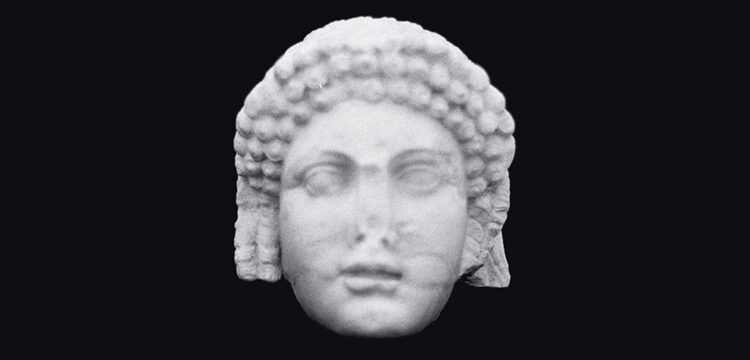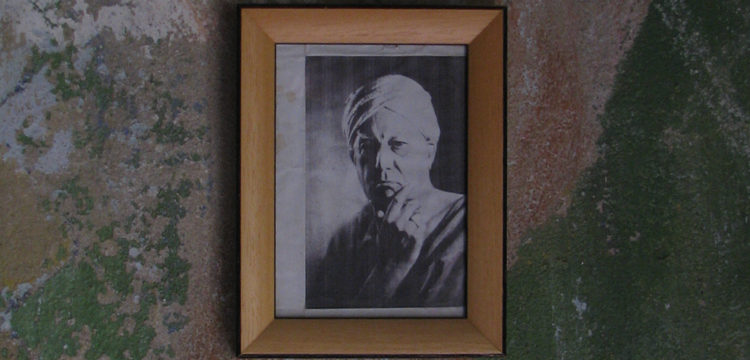Beyond Orientalism
An Arab-Sicilian school of poetry
Curated by Valentina Bruschi, the exhibition Viaggio in Sicilia #9 comprises a historical section curated by Evelina De Castro, director of Palazzo Abatellis. The show presents ten works by four contemporary artists, Bea Bonafini (Bonn, 1990), Gili Lavy (Jerusalem, 1987), Emiliano Maggi (Rome, 1977) and Diego Miguel Mirabella (Enna, 1988), a text by Chiara Barzini (Rome, 1979), photographs by Matteo Buonomo (Cinisello Balsamo, 1991), together with a selection of ten objects from the Islamic collections of the museum displayed for the first time. The exhibition design, curated by Beit Studio, takes its prompt from archival images of the Sala Araba dating from the early 20th century, which include the monumental chandelier restored for this occasion by Planeta.
“My hands are empty but my eyes are full of her memory” are the words that the Arab-Sicilian poet Ibn Ḥamdīs dedicates to Sicily, a land lost after the Norman conquest of the end of the 11th century. A verse with a contemporary force, quoted by writer Leonardo Sciascia in La corda pazza, as emblematic of the poetic representation of the theme of nostalgia and exile is part of a collection of over six thousand verses that make up the famous Canzoniere. Singer and composer Franco Battiato was also fascinated by this poet, and he dedicated to him the musical project, Diwan – L’essenza del reale, in homage to the 150th anniversary of the unification of Italy. Ibn Ḥamdīs was born in Syracuse in 1056 from a family of the Arab nobility and lived in Noto, from where he fled in 1078, with the arrival of the Norman soldiers. Like the migrants who today venture through the Mediterranean Sea, the poet fled the port of Marzamemi, bound for Al-Andalus and, once in Seville, was welcomed at the Arab court of the prince and patron Muhammad al-Mu’tamid. Yet he always had nostalgia for Sicily and dedicated many verses to his beloved lost island: “But more than crossing the sea, in my opinion, difficult are the things that forced you to cross it”. His poetry, like that of other Arab-Sicilian poets, inspired the metrics, rhythmicity and sonority of Sicilian and Provençal lyrics, up to the sonnets and alliterations of Jacopo da Lentini of the Sicilian school of poetry, defined by Dante as a precursor of the Dolce Stil Novo.
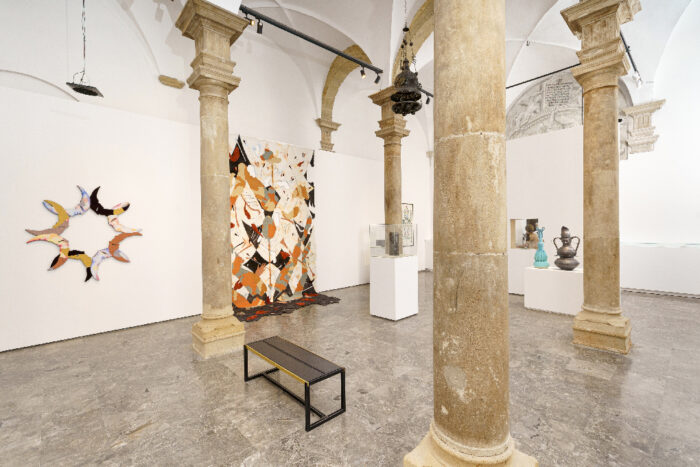
Another fragment of Arab-Sicilian poetry, this time by the philologist and poet Ibn al-Qattâ (Chalices of Stars Within the Sun’s Circle) gives the title to the exhibition presented in the Galleria regionale della Sicilia – Palazzo Abatellis, for the ninth edition of Viaggio in Sicilia, Planeta winery’s nomadic artist residency project. Verses referred to wine and natural phenomena to celebrate the precious traces of a rich production and an indelible mix of cultures. The Islamic occupation of Sicily is recognised by historians as a period of notable prosperity, which has left an indelible mark on agriculture, on engineering, art and poetry, contributing—amongst others—to the birth of the Sicilian school of poetry. The Sicilian archaeologist Antonio Salinas (1841–1914) firmly believed as much and, upon becoming director of the National Museum of Palermo—now the Archaeological Museum that bears his name—began planning the design of the Medieval Gallery, also known as the Sala Araba, denoting an epochal paradigm shift in advance of the rest of Europe. Under the influence of the illustrious politician, historian and orientalist Michele Amari (1806–1889), Professor of Arabic at the University of Florence and newly-unified Italy’s Minister of Education, Salinas exhibited a variety of objects that testified to the influence of Sicily’s period under Islamic domination, understood as an integral part of the distinctive regional Sicilian identity, fruit of the blending of cultures. Today we might define this historical experience as “beyond orientalism”, in reference to the homonymous 1978 book by Columbia professor Edward Said. Indeed, in that text the scholar reformulated the concept of “orientalism”, which he envisaged as a repository of images and stereotypes utilized by the West to impose its dominion on the Eastern Hemisphere. On the basis of such false conceptions, the West could render the East a locus of alterity, wherein resided everything that, to European cultural sensibilities, was not “Occidental”: the “other”. In fact, in the installation conceived by Salinas for his “Arabian Room” in the National Museum of Palermo, Arab-Islamic—along with Jewish—elements are understood as factors internal to and inseparable from the nation’s own history. Later, shortly after Salinas’s death, his Arabian Room was dismantled and some of the objects ended up in the museum’s deposits where they remained for over a century. Following the Second World War, a number of the artifacts exhibited in the Sala Araba were absorbed into the collections of Palazzo Abatellis.
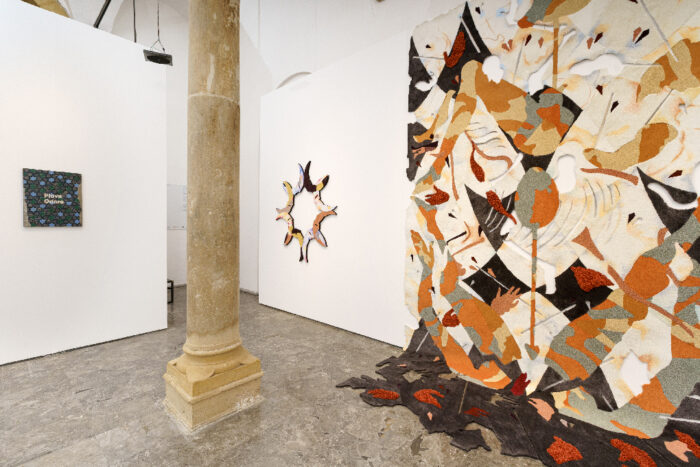
“The chandelier”, comments Evelina De Castro, “becomes emblematic of the continuity between a reinterpreted and idealized past and today’s creativity, consciously free from historicisms and superimpositions. The other artifacts of the Abatellis collections chosen for the exhibition respond to the criterion of the unpublished, of the most recurrent materials, such as wood and metal, but above all to the idea of presenting objects that tell stories of passages of use, in which the forms and repertoires, calligraphy, geometric and phytomorphic figures and stylizations, coming from stately models, become sources for contemporary art.” Together with this undertaking, a selection of other artifacts in metal and wood provide evocative testimony to the multifarious variety of objects part of the Abatellis collection. If this diversity derives from the many heterogeneous and eclectic collections gathered over time through confiscations, donations or acquisitions, it also attests to the modernity of Salinas’ museological vision, “decidedly in contrast to the presiding vision of the time, loaded with prejudice toward any artistic production not founded in Greco-Roman classicism.” Salinas’ aesthetic vision prefigured contemporary Cultural Studies, “devoid of preclusions, discrimination or hierarchy, giving birth to the ambitious project of using the museum’s spaces to illustrate, as thoroughly as possible, the evolution of art and cultural life in Sicily over the course of the centuries, publicly presenting artefacts of varied nature and implication (from the most august to the humblest), and of different periods and cultural backgrounds. In such a project, the legacy of Arab-Muslim culture was destined to assume a privileged position, insofar as it constituted one of the most striking and unique peculiarities of the cultural patrimony of Sicily, Palermo and its museum, as compared to the other regions of Italy.”
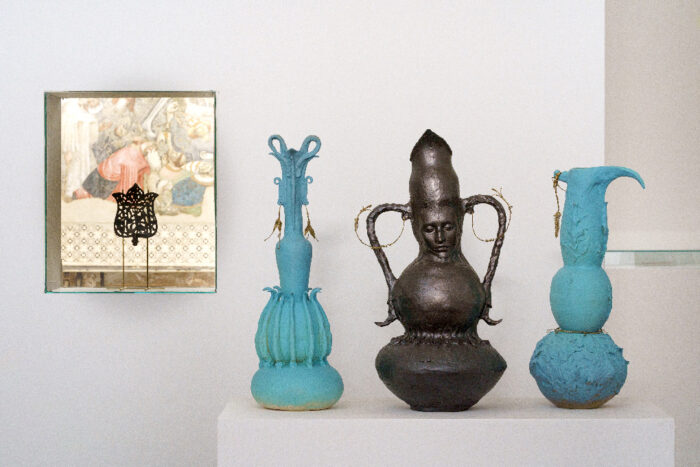
This exhibition seeks not only to recognise the visionary character of Salinas’ curatorial choices, but also to celebrate the vital rediscovery of Sicilian Arabic poetry throughout the same years, again by merit of Michele Amari, which was to shed new light on the Arabic culture present in Sicily. Indeed, as the scholar was absorbed in re-editing and publishing material destined for his monumental Storia dei Musulmani di Sicilia (Muslims’ History in Sicily, 1854–1872), he printed the translated literary anthology Biblioteca arabo-sicula (The Sicilian Arabic Library) in Leipzig in 1857. Others duly began to apply themselves to the theme. Years later, Celestino Schiaparelli, Amari’s disciple and friend, published the poetry cycle of Ibn Ḥamdīs, a work of 6,000 lines of poetry and the only similar corpus to reach us in its entirety. Schiaparelli duly translated the surviving parts of another, partially lost, collection: that of the poet al-Ballanūbī, which was first published only in 1959 with the scholar Umberto Rizzitano as editor under the aegis of Cairo University.
Contemporary artists have always studied museum collections. For this project, in addition to their itinerant residency across the various Planeta estates, the artists—Bea Bonafini, Gili Lavy, Emiliano Maggi and Diego Miguel Mirabella—continued along the trail of Sicilian Arabic culture through contemplation of works in the Abatellis collection. During and after the residency, the artists found a constant point of reference in reading the verse of noted Sicilian Arabic poets, whose descriptive acuity and delicacy of gaze combined to create deeply suggestive works recounting the magnificent beauty of that era’s Sicily, amongst other themes. Whether addressing Palermo’s royal palace and gardens, much extolled by the two poets of the name Abd al-Raḥmān, or—in the writings of the most important of the Arabic poets, the aforementioned Ibn Ḥamdīs—decorous evocations of a storm-tossed sea, war or an exile’s regret, the rich production of the Sicilian Arabic school of poetry left the invaluable record of an indelible interweaving of cultures.
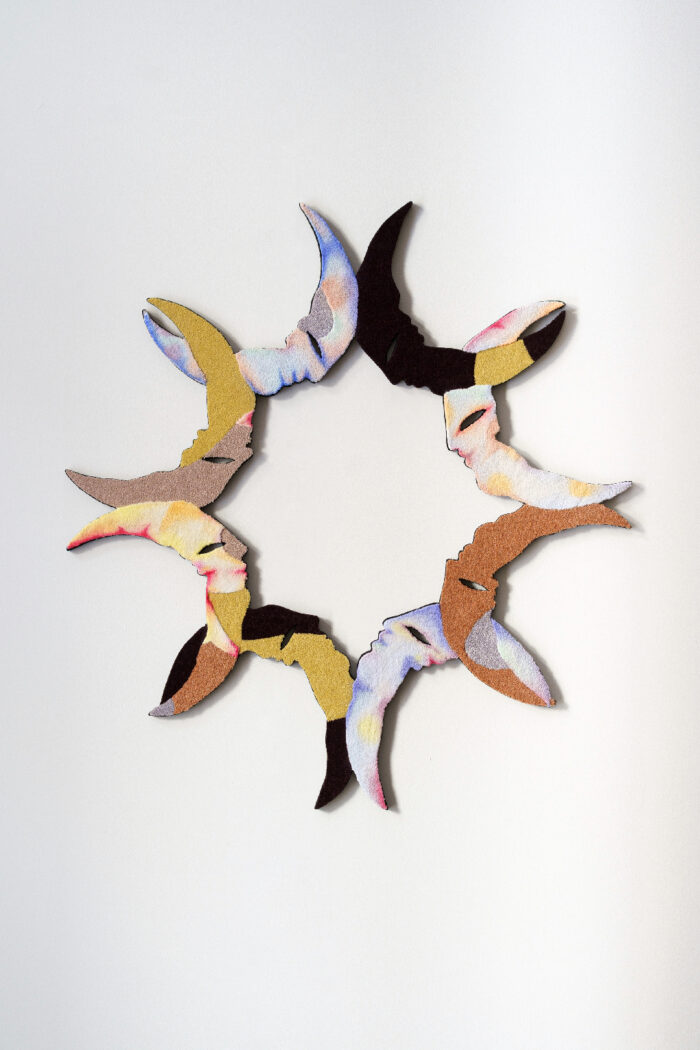
Gili Lavy has contributed a sound installation in collaboration with the musician Jacopo Salvatori, entitled Journey XII, invoking words from the Mediterranean lingua franca, Sabir. A suggestive dialogue unfolds in Sabir, sung in this case, between two voyagers by sea—the same sea that, as Lavy has noted, exercises all its allure from the moment one steps from the Palazzo Abatellis doorway onto Via Alloro. The artist thereby refers to the museum as a space of transition containing manifold protean identities, some of them fused together, in a metaphor for Sicily itself: an immense archive of cultures in migration. Lavy also succeeds in reviving the ancient spirit enclosed in the walls of the museum, once a convent inhabited by cloistered nuns. Her work illustrates the overlapping of temporal strata and the enrichment they offer to anyone receptive to their implications: those of time becoming history, as it has here.
Emiliano Maggi produced three sculptures in ceramic and bronze, akin to jugs, to symbolize the verses of the aforementioned Sicilian Arabic poet al-Ballanūbī, rediscovered by Michele Amari in the nineteenth century. For the opening of the exhibition, Emiliano Maggi also staged a performance entitled La sua bocca custodisce perle di denti che rivelano perle d’amore (The mouth that contains pearls of teeth revealing pearls of love), employing flutes and string instruments similar to komuz, constructed by the artist in an experimental combination of ceramic and wood. Similar instruments appear in the painted depictions of musicians and musical instruments in the ceiling muqarnas of the Palatine Chapel, together with the ud, the rabāb and the lute. In turn the artist composed an original piece for the performance, interpreting the theme of love ever-present in al-Ballanūbī’s cycle of poetry.
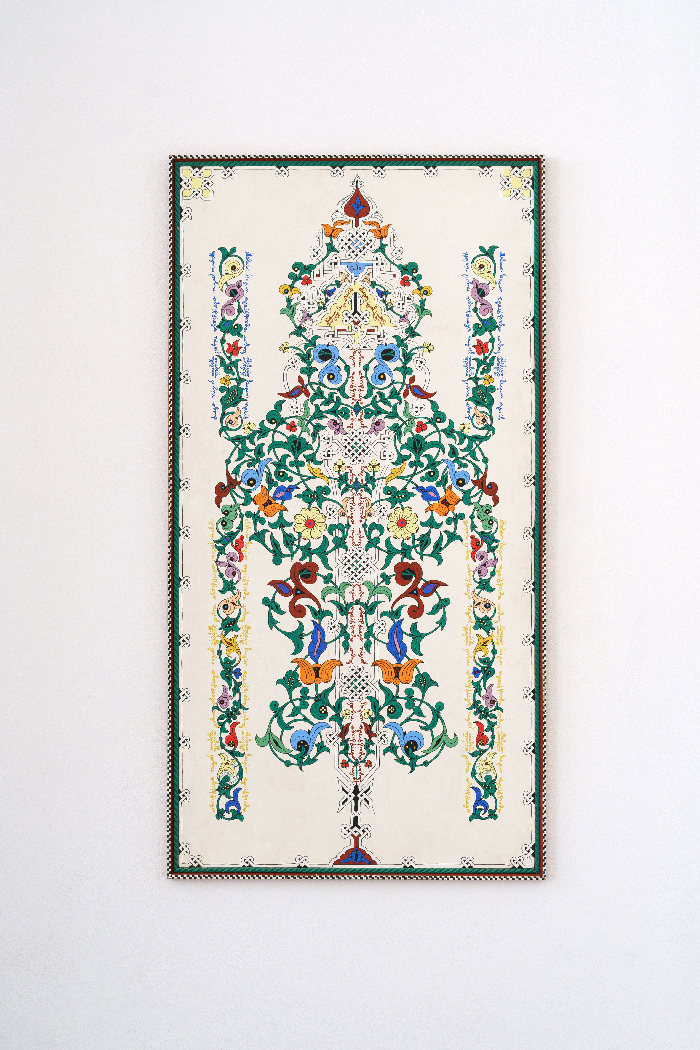
Diego Miguel Mirabella has instead presented an installation utilizing fabrics, a gouache on wooden panel and a mosaic, all realized in collaboration with Moroccan artisans, as a further extension of his investigation into the grammatical structures of ornament and decoration. Although the narrative element is always highly important to Mirabella’s work, the words that appear in his pieces are always mysterious, as if they hid elusive secrets. They become fragmentary poetry, as he himself defines them—such that, were all his works gathered together over the course of time, they would themselves become a narration of his own Sicilian way of being. But they are words partly obscured by decorations, granting only partial clues as to their essence: one less revealed than intuited, enabling the concealment that constitutes another fundamental aspect of his work. Here it is interesting to note a conceptual correlation to the Sicilian poet Lucio Piccolo di Calanovella, who entitled one of his poems Gioco a nascondere (Hide and Seek, 1960), included in the collection of the same name.Bea Bonafini is the only artist present who, as well as presenting a work created for the occasion—Immortal Eye, from the verse of the aforementioned Ibn Ḥamdīs, one of the greatest exponents of Sicilian Arabic poetry, born in Noto in 1056 and deceased in Majorca in 1133—has also exhibited an imposing rug-tapestry in carpet, dating from 2018. The latter, entitled Il Trionfo, was created in reference to the celebrated fresco Il Trionfo della Morte. Held in the museum, the Trionfo’s distinctive iconography is attributable to the wide diffusion of courtly repertories in painting, miniatures, tapestries, decorative arts and the illustrations accompanying hunting treatises or herbals. The theme of falconry, in particular, was typical of the Islamic repertory: it was amongst the favorite pastimes of the royalty and assumed a foreground role amongst the decorative patterns applied to Sicilian artifacts of Arab tradition, whether in ceramics, ivory or painted on wood. On this note, it is worth remembering Emperor Frederick II’s passion for hunting, in particular for falconry, to which we owe the celebrated De Arti Venandi cum Avibus, an ornithological-venatic treatise demonstrating the scientific interests of the Swabian sovereign and his refined court in Palermo.




